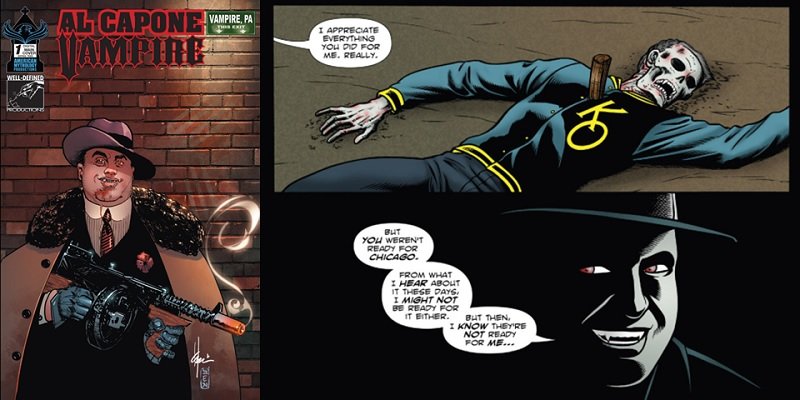[Flashback] ‘The Vampyre’ by John Polidori—revising vampire folklore into the monster seen in vampire stories today.
It’s crazy to consider that two of the most important monster stories of all time were part of the same writing contest.
Polidori has been credited with revising vampire of folklore, changing it into the humanistic monster now often seen in vampire stories today.
In pop culture today, vampires are all over the place—in everything from novels and comic books to movies and TV shows to video games and everything else. But looking back over the history of vampire fiction, what we see now in this category is quite a change from its origins in folklore.
And while we often look back on Bram Stoker’s 1897 literary classic Dracula as the iconic beginnings of modern vampire legend—the fact is that there are some earlier relevant examples.
Like the 1819 story The Vampyre by John Polidori.
Often considered the origin of the romantic vampire genre, The Vampyre has been described by Christopher Frayling as “the first story successfully to fuse the disparate elements of vampirism into a coherent literary genre.”
In fact, the classic 1931 Universal Monster movie Dracula, starring Bela Lugosi, wasn’t just an adaptation of Stoker’s novel. There were stylish character elements that actually came from Polidori’s approach. Polidori has been credited with revising vampire of folklore, changing it into the humanistic monster now often seen in vampire stories today.
Monster Complex uses Amazon affiliate links.
The Vampyre vs Frankenstein
So, it’s crazy to consider that two of the most important monster stories of all time were part of the same writing contest. But Polidori’s The Vampyre and Mary Shelley’s legendary novel Frankenstein; or, The Modern Prometheus were both entries in the same monster story contest where everyone at the party didn’t want to go outside.
That event, of course, Monster Complex has talked about both here and here. (Frankenstein is a big deal to us.) In fact, we got lots of Frankenstein stuff here: Celebrating Frankenstein
The writing contest took place in 1816 during the Year Without a Summer. Europe and parts of North America were suffering weather problems caused by volcanic eruptions in Indonesia.
While in Switzerland, Lord Byron invited Mary Wollstonecraft Godwin, Percy Bysshe Shelley, and Claire Clairmont to the mansion he was renting. Stuck indoors by the heavy rains, the group spent three days sharing weird tales.
After relating ghost stories, they then decided to write some stories of their own. Byron wrote a fragment of a horror story that eventually inspired John Polidori’s The Vampyre. Polidori s result was published on April Fool’s Day in 1819. It appeared in the New Monthly Magazine mistakenly credited as “A Tale by Lord Byron.”
About the book The Vampyre
A wealthy man named Aubrey meets Lord Ruthven at a social event in London, and they travel to Europe together but part ways in Rome. Aubrey travels to Greece, where he falls in love with a local woman named Ianthe, who tells Aubrey of local vampire legends.
When Ianthe is killed, the townspeople believe it is the work of a vampire. Lord Ruthven rejoins Aubrey, but Lord Ruthven is fatally wounded and dies during their travels. When Aubrey returns to London, he sees Lord Ruthven alive and well, seducing his sister, who he kills on the day of their marriage before disappearing.
Find The Vampyre by John Polidori at Amazon
The book was a success—partially because of the Byron attribution—but also because it took advantage of the public’s fondness for gothic horror. While vampire folktales up until then were more beastly and violent, Polidori transformed the vampire image into the type we recognize today—an aristocratic fiend who preys among high society.
Thanks to Polidori, vampires were changed into handsome predators—creatures of polite society. In fact, Lord Ruthven is based on Lord Byron—the two have many things in common. They’re both handsome, apathetic, high members of society with sexual appetites.
Polidori’s work has over the years had an immense impact on contemporary sensibilities, and has run through numerous editions and translations. The modern vampire fiction revisits to that era usually references Dracula—the irony being that they’re often touching on a Lord Ruthven version of Dracula.
Now, Polidori’s Ruthven is a major character in Kim Newman’s epic Anno Dracula series. In that alternate universe, he is a prominent figure in British politics following the rise of—well—Dracula. As the story moves toward the present day, Lord Ruthven succeeds Margaret Thatcher as Prime Minister. Related: Interview: ‘Anno Dracula’ Author Kim Newman
The legacy of classic vampire literature
There have been more sophisticated (and explicit) examples of vampire tales in the 200-plus years since Polidori’s The Vampyre first appeared.
Joseph Sheridan Le Fanu popularized the female vampire in his 1872 novel Carmilla. (We talk about that one here.)
Bram Stoker took the lordly fiend to new heights in his 1897 novel Dracula (which we talk about here and will be talking more about that again soon).
In the years since, storytellers obsessed with vampires have included novelists, poets, playwrights, artists, filmmakers, comic book creators and more. (Some of which we cover here.)
Vampyre Read-throughs
I Read You The Vampyre | Maven of the Eventide | Part 1
I Read You The Vampyre Part 2 | Maven of the Eventide
More vampire articles on Monster Complex
Related articles on Monster Complex
True Blood: Charlaine Harris Sookie Stackhouse Books In Order
Complete Kate Daniels Series by Ilona Andrews in Order + Q&A
L.A. Banks: ‘Minion: Vampire Huntress Legend’ #1—the beast is coming for her…
Nicolas Cage is Dracula—but RENFIELD is “Really Nicholas Hoult’s movie”
‘Classic Monsters Unleashed’ by Jonathan Maberry, Seanan McGuire, Owl Goingback, and more
Who WROTE the Vampire Diaries books? Don’t believe the name on the cover…
‘What We Do in the Shadows’ Fans—16 Vampire Books You Should Check Out
60+ Special Vampire Book Series—from Anne Rice, L.A. Banks, Charlaine Harris, more
Related links across the Internet
Perverse passions that will not die: The modern vampire first walked among us two centuries ago (The Conversation)
The Norfolk doctor who brought a vampire to life (Great British Life)
Dracula and Frankenstein's Monster: How the Undead Were Born | Texas Tech Today (Texas Tech Today)
The Birth Of The Vampire: 200 Years Of The Genre (History Extra)
20 Best Vampire Books of All Time (Esquire)
Vampire's rebirth: from monstrous undead creature to sexy Byronic seducer in one ghost story (The Conversation)
Vampire myths originated with a real blood disorder (The Conversation)
The top 10 vampire books (The Guardian)
The 20 Best Vampire Movies | Movies | Empire (Empire Online)
Vampires aren't just bloodthirsty, they remind us what it means to be human (The Big Issue)
12 Mind Blowing Facts About Vampires (WhatCulture.com)
80 years before Bram Stoker, it was a young English doctor who introduced us to the modern vampire (Scroll.in)
The Haunted Writing Life of John Polidori (The Millions)
















Looking for more options to watch classic monster movies like Frankenstein or Godzilla? Offering a bunch of websites with movies and TV shows—including stuff you can watch free, rent or buy.